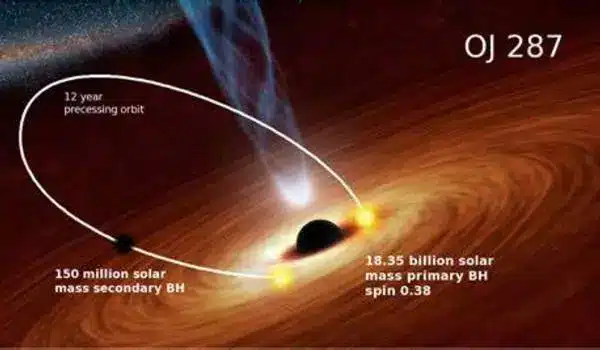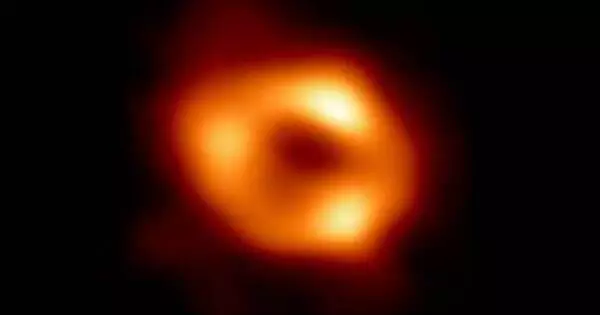Supermassive black holes are often located in galaxies’ centers, and they are not known to form binary systems in the same way that smaller stellar-mass black holes can. The study of supermassive black holes and their environs, on the other hand, is an active area of research in astrophysics, with new findings being discovered on a regular basis.
At the centers of active galaxies, supermassive black holes several billion times the mass of our Sun can be found. Astronomers see them as bright galactic centers where a supermassive black hole devours matter from a furious whirlpool known as an accretion disk. A portion of the substance is sucked into a forceful jet. The galactic core shines brightly over the whole electromagnetic spectrum as a result of this activity.
In a recent study, astronomers discovered evidence of two supermassive black holes circling each other via signals from jets associated with matter accretion into both black holes. The galaxy, or quasar as it is formally known, is known as OJ287, and it is best researched and understood as a binary black hole system. The black holes in the sky are so close together that they coalesce into one dot. The fact that the dot is made up of two black holes is revealed when it produces two different sorts of signals.
At a distance of around 5 billion light years, the active galaxy OJ 287 has been spotted by astronomers since 1888. Aimo Sillanpää of the University of Turku and his colleagues discovered a notable pattern in its emission more than 40 years ago, with two cycles, one of about 12 years and the other of around 55 years. They proposed that the two cycles are the result of two black holes orbiting one other. The shorter cycle is the orbital cycle, while the longer one is caused by the slow evolution of the orbit’s orientation.
The period in 2021/2022 had a special significance in the study of OJ287. Earlier, it had been predicted that during this period the secondary black hole would plunge through the accretion disk of its more massive companion.
Professor Mauri Valtonen
The orbital motion is revealed by a sequence of flares produced when the secondary black hole plunges frequently through the parent black hole’s accretion disk at speeds a fraction slower than the speed of light. The secondary black hole’s plunge heats the disk material and the hot gas escapes in expanding bubbles. These heated bubbles take months to cool while radiating and causing a flash of light — a flare — that lasts about a fortnight and is brighter than a trillion stars.
After decades of estimating the timing of the secondary black hole’s plunge through the accretion disk, astronomers led by Mauri Valtonen of the University of Turku in Finland and his collaborator Achamveedu Gopakumar of the Tata Institute of Fundamental Research in Mumbai, India, and others were able to model the orbit and predict when these flares would occur.
The team was able to witness the predicted flares and confirm the presence of a supermassive black hole pair in OJ 287 thanks to successful observational campaigns in 1983, 1994, 1995, 2005, 2007, 2015, and 2019.

“There have now been 26 predicted flares, and nearly all of them have been observed.” Professor Achamveedu Gopakumar states, “The larger black hole in this pair weighs more than 18 billion times the mass of our Sun, while the companion is roughly 100 times lighter, and their orbit is oblong, not circular.”
Despite their attempts, scientists have yet to detect a direct signal from the tiny black hole. Prior to 2021, its existence could only be established indirectly from flares and the way it causes the jet of the larger black hole to waver.
“The two black holes are so close to each other in the sky that one cannot see them separately, they merge to a single point in our telescopes. Only if we see clearly separate signals from each black hole can we say that we have actually “seen” them both,” says the lead author, Professor Mauri Valtonen.
Smaller black hole directly observed for the first time
Excitingly, observational campaigns on OJ 287 in 2021/2022 using a large number of telescopes of various types enabled researchers to obtain observations of the secondary black hole plunging through the accretion disk for the first time, as well as signals emitted by the smaller black hole itself.
“The period in 2021/2022 had a special significance in the study of OJ287. Earlier, it had been predicted that during this period the secondary black hole would plunge through the accretion disk of its more massive companion. This plunging was expected to produce a very blue flash right after the impact, and it was indeed observed, within days of the predicted time, by Martin Jelinek and associates at the Czech Technical University and Astronomical Institute of Czechia,” says Professor Mauri Valtonen.
However, there were two major surprises: new sorts of flares that had not before been detected. For good reason, the first of them was only seen by a meticulous observation effort directed by Staszek Zola of the Jagiellonian University in Cracow, Poland. Zola and his colleagues witnessed a massive flare that produced 100 times the light of an entire galaxy and lasted only one day.
“The flare occurred shortly after the smaller black hole received a massive dose of new gas to swallow during its plunge, according to estimates. The dramatic brightness of OJ287 is caused by the swallowing process. This process is considered to have empowered the jet that bursts out of OJ-287’s tiny black hole. An event like this was predicted ten years ago but has not been confirmed until now,” Valtonen explains.
The second unexpected signal was seen by NASA’s Fermi telescope and was caused by gamma rays. The largest gamma-ray flare in OJ287 in six years occurred right as the smaller black hole crashed through the larger black hole’s gas disk. The smaller black hole’s jet interacts with the disk gas, resulting in the creation of gamma rays. To back up this theory, the researchers discovered that a similar gamma-ray flare occurred in 2013 when the little black hole passed through the gas disk the last time, as seen from the same vantage point.
“What about the one-day burst, why haven’t we seen it before?” OJ287 has been photographed since 1888 and has been closely tracked since 1970. It turns out that we were merely unlucky. Nobody saw OJ287 on those nights when it performed its one-night stunt. “And we would have missed it this time as well if it hadn’t been for Zola’s group’s intense monitoring,” Valtonen says.















